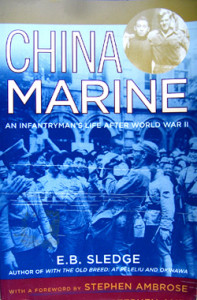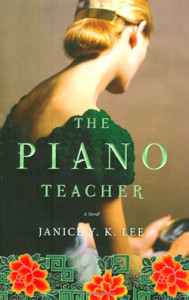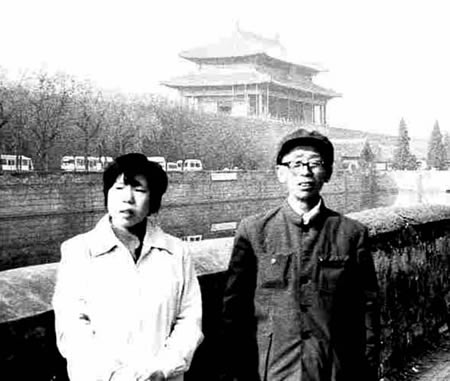


When I first encountered Beijing the year after Tiananmen Square the streets still jingled with bicycle bells and he soft whirr of the chains of Flying Pigeon bicycles and the ubiquitous and amazingly versatile utility trikes. China was called (among other things) zixingche da guo, the Kingdom of Bicycles. I wandered through gritty old hutongs, the compounds of narrow residential lanes that it felt like “breaking and entering.” I will never forget, but have a reminder photo, stopping to pee in a public toilet built into the wall of the hutong—where China was still very much in an olfactory way, still back in the 1940s.
Cut to my sixth and most recent visit in 2008 and the jingling bike bells have all but gone silent, replaced by the horns of Beemers, Benzes and Jags, the expensive models, precariously operated by the newly automotive Chinese—with cell phones. In the span of a couple of decades the city I was only beginning to know is almost transmogrified, jumping headlong into capitalism and international style and culture. My sense if Beijing before I went there was very much shaped by the Mao era and by books such as René Leyes Victor Segalen, novels such as Seymour Toping’s The Peking Letter, and by grainy photos of broad empty avenues and people sweeping up after Gobi dust clouds and industrial plan emissions. Concrete grey is the default color of much of Beijing. That was not the Beijing I found when I arrive in the Deng era; even the place I knew then is rapidly disappearing. I manage to get only a couple of photos of those guys in Mao suits and caps (although one can still find more in regional cities and towns).
So I have to rely on excellent accounts such as David Kidd’s Peking Story to take me back to the Beijing of my youthful imagination. There is the title—Peking—and the cover photo, a black and white of the author in his early twenties, epicene, self-possessed, staring confidently back at the camera, and unfiltered cigarette dangling from his fingers. Kidd writes from an era I could only try to imagine. His years in Peking, from 1946 to 1951 were transformative for both him and the city, which is why he could subtitle his account “the last days of old China.”
Kidd was a student of Chinese culture, reasonably fluent in Mandarin and, given that his dedication is to the American Ambassador to China, appears to have been well-connected. That may be how he ended up living in the mansion of a wealthy traditional family. His story opens with preparations to marry Aimeé Yu, one of the daughters of the pater familias. But the old man dies just as they are married, and the decorum of mourning erases their honeymoon. Had they not been required by the American authorities to find some sort of cleric to officiate they could have married according to Chinese custom, wherein a marriage “letter” was prepared and “chopped” the newlyweds and witnesses. Divorce, should it become necessary is achieved simply by tearing up the letter.
The reader gets the feeling of being on the edge of changes. The 101-room mansion, filled with children, spinster aunts that chain-smoke cigarettes and play mahjong, surrounded by immensely valuable antiques, seems an anachronism more befitting a medieval seigneur in some rural town rather than an urban residence. But in 1946 sprawling Beijing still contained residue of the past beyond the Forbidden City.
But not for long. Soon Red troops are being quartered in the house’s courtyards and the eventual control mechanisms of the new order begin to clamp down on the old way of life. What this reader found interesting were the little details. For example, the Communists considered dogs to be a waste of precious food (or food themselves?), and dogs soon began to disappear. There was also an explanation for those photos I remember of people sweeping the streets; that was a task that was meted out as a punishment for minor infractions.
Kidd and his wife decamped for America before things got worse. They eventually separated and he returned alone after the Cultural Revolution was over to see if he could locate some of his in-laws. The old mansion and its antiques were gone and the family dead and/or scattered into crowded and mean accommodations. He did find a few relatives, one, and aged “aunt” who told him about “Bloody August,” a month at the beginning of the Cultural Revolution that was never reported in the West during which red Guards hauled thousands of people out of their homes and beat them to death with clubs. As a lo wai (foreigner), Kidd would almost certainly have been a victim.
Kidd could have crossed paths with another American in the years immediately after WWII. E.B. Sledge came from quite different circumstances. Instead of being immediately sent home after bloody combat at Peleliu and Okinawa, Sledge was assigned to be a China Marine, with rather ambiguous duty in Peking in 1946. Possession of Peking was being contested by the Kuomintang and the Communists and there were still Americans in the city. American sentiments were, of course, slanted toward the Nationalists. There were still Japanese around, although they had surrendered. The last thing Sledge’s First Marine Division wanted was to become a casualty of the reinvigorated Chinese family spat.
Determined to make the best of a difficult situation Sledge befriended their barrack houseboy and got him to teach him some Mandarin. He made forays into the city, observing the people and their customs and visited parks, monuments and the Forbidden City. Sledge was no social anthropologist, and he has been fighting Asians in the South Pacific, but he combined a certain American Southern gentility with a realism about his circumstances. Like David Kidd, he too became involved with an educated Chinese family. The Soongs—not the famous Soongs(1) who were intimately connected with political power in China –were what we would regard as an upper middle class family; the father, Y.K Soong, was a physician and both wife and daughter were educated. The family had also “adopted” a former Japanese prisoner of war, a Belgian Catholic priest, Fr. Marcel von Hemelryjck, who was fluent in Chinese as well as Russian, French and Japanese. Sledge communicated with the family, who spoke French, through the priest, at dinners and social occasions at ghe Soong home. He write that “Meeting the Soong family and Father Marcel was one of the happiest events of my entire life.”
After he returned to the states Sledge corresponded with the Soongs and Fr. Marcel. But after the Communist takeover of Peking he never heard from the Soongs again. Fr. Marcel has relocated to a Catholic university in America. Not long after he passed away. Sledge went on to obtain a Ph.D. in Biology and had a long teaching career. But it is clear that the war, and his time as a “China Marine” were indelible features of his life.(2)
It is a bit of a stretch to include a novel set in Hong Kong that straddles the Japanese invasion in 1941, but it, too, is a story of a lo wai, in this case a young Englishwoman who comes to Hong Kong when her husband is transferred there, and becomes involved with a Chinese family as The Piano Teacher. Although Claire Pendleton is clearly a hireling of the wealthy Chen family to teach their young, but uninterested, daughter the piano, she is introduced to the society of wealthy British and Chinese who remain after the war. She also meets Will Trusdale, the Chen driver, who, we know from chapters set before and during the war, had a love affair with the wealthy Macau daughter of a Chinese and beautiful Portuguese woman. Author Yee has clearly done her research on the period, especially about the conditions in the POW camp in Stanley.(3) But there is a flatness of the characters in this story. Yee spends more time describing clothing and jewelry than she does on the mores and motives of her lead personalities. Claire is a minor kleptomaniac, but we don’t get to know why. There is no piano teaching in the story. There is a lot of partying that gives the tale a feeling of imminent change (which there certainly is), but the Japanese we get to know most about is an officer who keeps Trudy Liang as somewhat of a comfort woman, but maintains for her some of the comforts to which she is accustomed. Trudy helps keep her British lover, Trusdale, alive, but then she disappears. Unfortunately, all the characters in this novel seem stereotypical and never seem to be able to get beyond that. The real stories of Westerners and their encounters with Chinese families, as recounted by Sledge and especially Kidd, seemed much more alive.

Dad and daughter alongside moat north of Forbidden City, Beijing
©1991, James A. Clapp
____________________________________________________________
©2009, James A. Clapp (UrbisMedia Ltd. Pub. 5.21.2009)
1. See Sterling Seagrave, The Soong Dynasty (1986)
2. He also wrote With the Old Breed: At Peleliu and Okinawa
3. I recommend Prisoner of the Turnip Heads: The Fall of Hong Kong and the Imprisionment by the Japanese, by George Wright-Nooth and Mark Adkin (2000)
